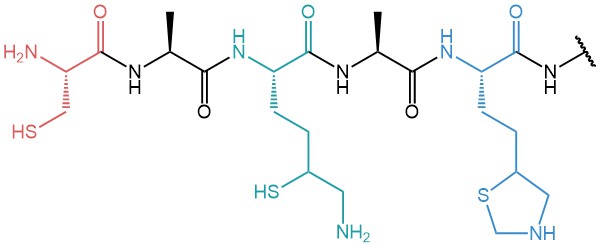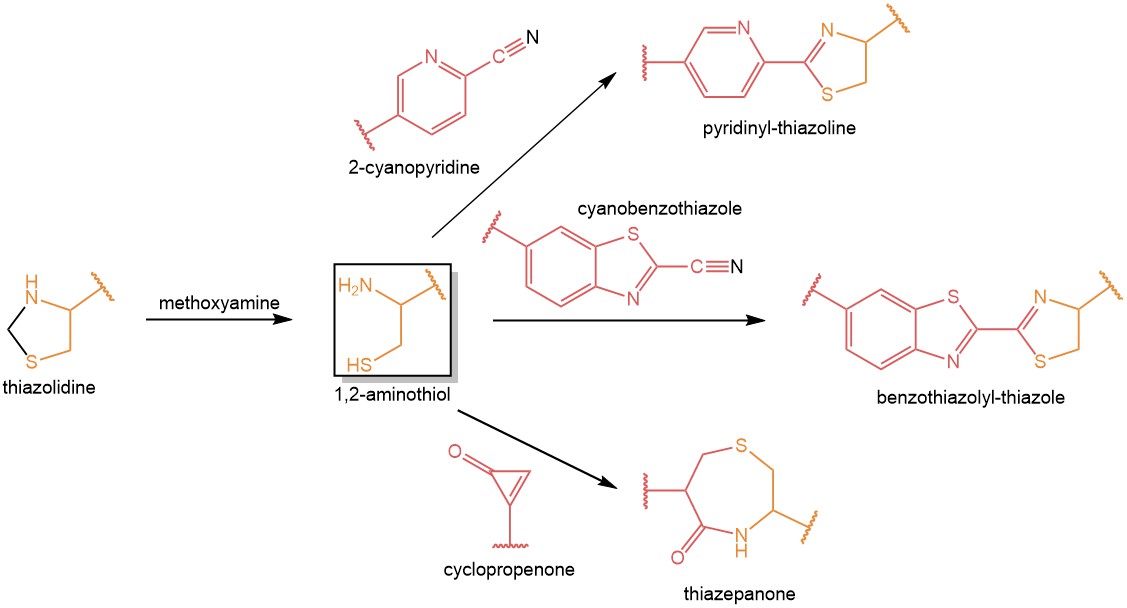Welcome to Iris Biotech
For better service please confirm your country and language we detected.

For better service please confirm your country and language we detected.

Thank you very much for your interest in our products. All prices listed on our website are ex-works, Germany, and may attract customs duties when imported.
You may/will be contacted by the shipping company for additional documentation that may be required by the US Customs for clearance.
We offer you the convenience of buying through a local partner, Peptide Solutions LLC who can import the shipment as well as prepay the customs duties and brokerage on your behalf and provide the convenience of a domestic sale.
Continue to Iris Biotech GmbHSend request to US distributorPublished on 16.04.2024

While internal cysteines have a long history as easy target for protein derivatization and for attaching payloads, e.g., by reacting them with maleimides, their modification frequently interferes with the formation of disulfide bridges (which however sometimes are essential for correct protein function) or the role of cysteines as essential parts of the catalytic core of enzymes. 1,2-Aminothiols in contrast allow specific modifications without affecting structurally relevant amino acids.
In solid phase peptide synthesis (SPPS), 1,2-aminothiols may be incorporated as non-canonical amino acids at any position. N-terminal cysteines (NCys) are special cases of 1,2-aminothiols. In recombinant proteins, providing an NCys is an easy task utilizing TEV protease; as a third option, 1,2-aminothiols may be introduced by SPPS in a protected form as thiazolidine and later deprotected with methoxyamine (O-methylhydroxylamine). This can be done in neutral aqueous solutions, usually in situ, right before the actual click-like reaction is initiated.

Exemplary peptide sequence with an N-terminal cysteine (NCys), an internal 1,2-aminothiol and a thiazolidine, the protected version of an 1,2-aminothiol.
1,2-Aminothiols are an excellent match for mono- and dicyanopyridines to generate cyclic peptides, but they offer even more possibilities: 1,2-aminothiols also undergo click-like reactions with cyclopropenones (CPO, forming 1,4-thiazepan-5-one rings) and with cyanobenzothiazoles (CBT), they may be used as non-canonical amino acids and for branching peptide chains. Furthermore, 1,2-aminothiols also can serve as template for native chemical ligation (NCL), which also may be utilized for ubiquitinoylation with ubiquitin thioesters.

1,2-Aminothiols offer several possibilities for bioorthogonal click-like derivatization at neutral aqueous conditions, e.g., with 2-cyanopyridines, cyanobenzothiazoles, or cylopropenones.
Iris Biotech provides a selection of non-canonical amino acid building blocks which allow the direct introduction of 1,2 aminothiols and thiazolidines at any position during SPPS.
→ You want to learn more about Click Chemistry or click-like reactions? Download our brochure or read our blog about the CBT click reaction!
References:
The Cyanopyridine-Aminothiol Click Reaction: Expanding Horizons in Chemical Biology; C. Nitsche; SynLett. 2024; 35: A-E. http://dx.doi.org/10.1055/a-2214-7612
Biocompatible and Selective Generation of Bicyclic Peptides; S. Ullrich, J. George, A. Coram, R. Morewood, C. Nitsche; Angew Chem Int Ed. 2022; 61(43): e20228400. https://doi.org/10.1002/anie.202208400
Platform for Orthogonal N‑Cysteine-Specific Protein Modification Enabled by Cyclopropenone Reagents; A. Istrate, M. Geeson, C. Navo, B. Sousa, M. Marques, R. Taylor, T. Journeaux, S. Oehler, M. Mortensen, M. Deery, A. Bond, F. Corzana, G. Jiménez-Osés, G. Bernardes; J Am Chem Soc. 2022; 144(23): 10396-10406. https://pubs.acs.org/doi/10.1021/jacs.2c02185
Chemical Synthesis of Ubiquitin, Ubiquitin-Based Probes, and Diubiquitin; F. El Oualid, R. Merkx, R. Ekkebus, D. Hameed, J. Smit, A. de Jong, H. Hilkmann, T. Sixma, H. Ovaa; Angew Chem Int Ed. 2010; 49(52): 10149-10153. https://doi.org/10.1002/anie.201005995
Highly Efficient and Chemoselective Peptide Ubiquitylation; K. Ajish Kumar, M. Haj-Yahya, D. Olschewski, H. Lashuel, A. Brik; Angew Chem Int Ed. 2009; 48(43): 8090-8094. https://doi.org/10.1002/anie.200902936
Traceless and Site-Specific Ubiquitination of Recombinant Proteins; S. Virdee, P. Kapadnis, T. Elliott, K. Lang, J. Madrzak, D. Nguyen, L. Riechmann, J. Chin; J Am Chem Soc. 2011; 133(28): 10708–10711. https://doi.org/10.1021/ja202799r
Tobacco Etch Virus protease: A shortcut across biotechnologies; F. Cesaratto, O. Burrone, G. Petris; J Biotechnol. 2016; 231: 239-249. https://doi.org/10.1016/j.jbiotec.2016.06.012
Native Chemical Ligation and Extended Methods: Mechanisms, Catalysis, Scope, and Limitations; V. Agouridas, O. El Mahdi, V. Diemer, M. Cargoët, J. Monbaliu, O. Melnyk; Chem. Rev. 2019; 119(12): 7328-7443. https://doi.org/10.1021/acs.chemrev.8b00712